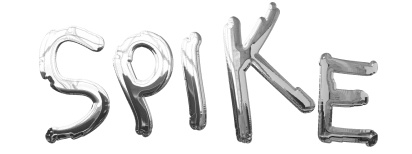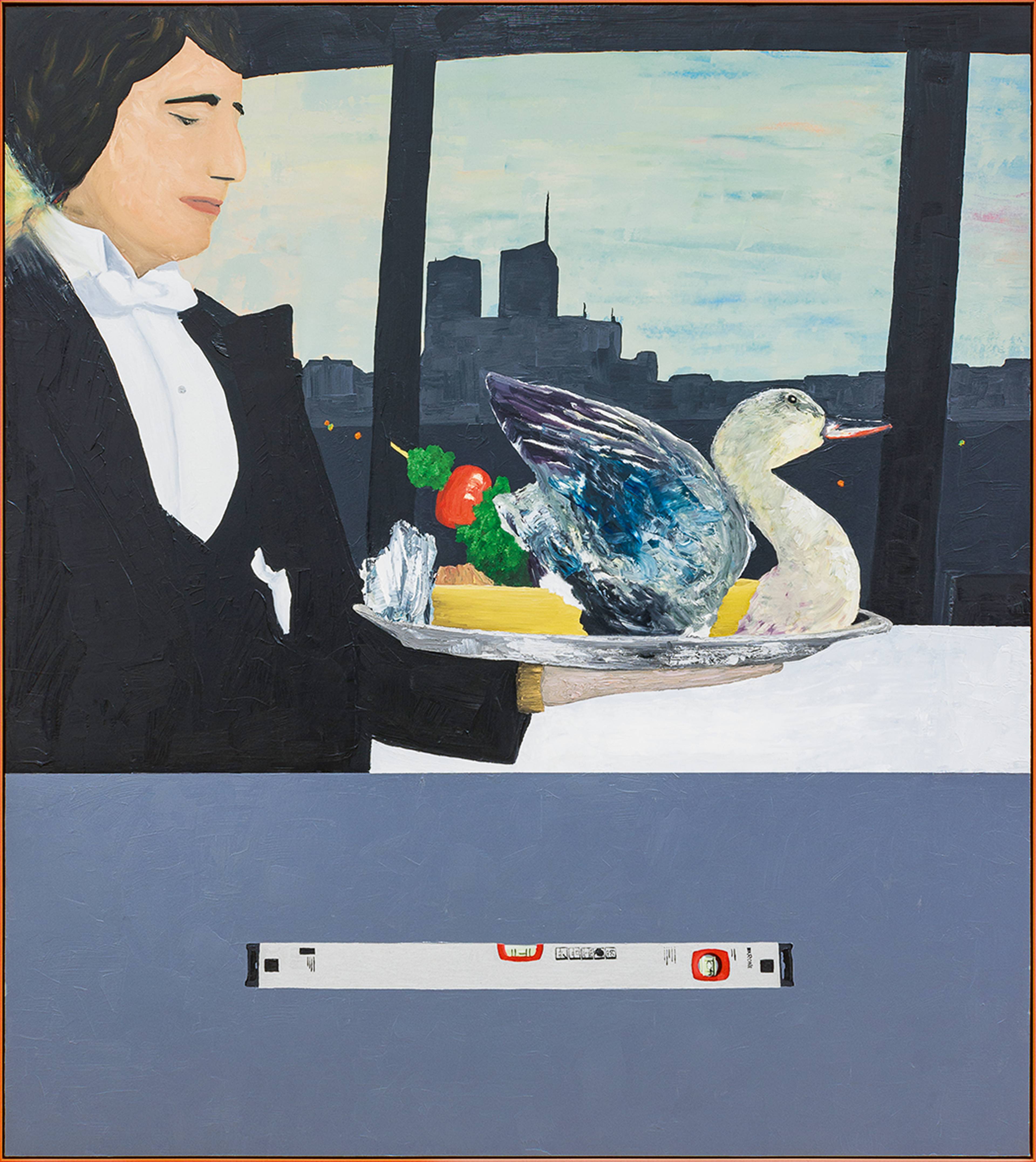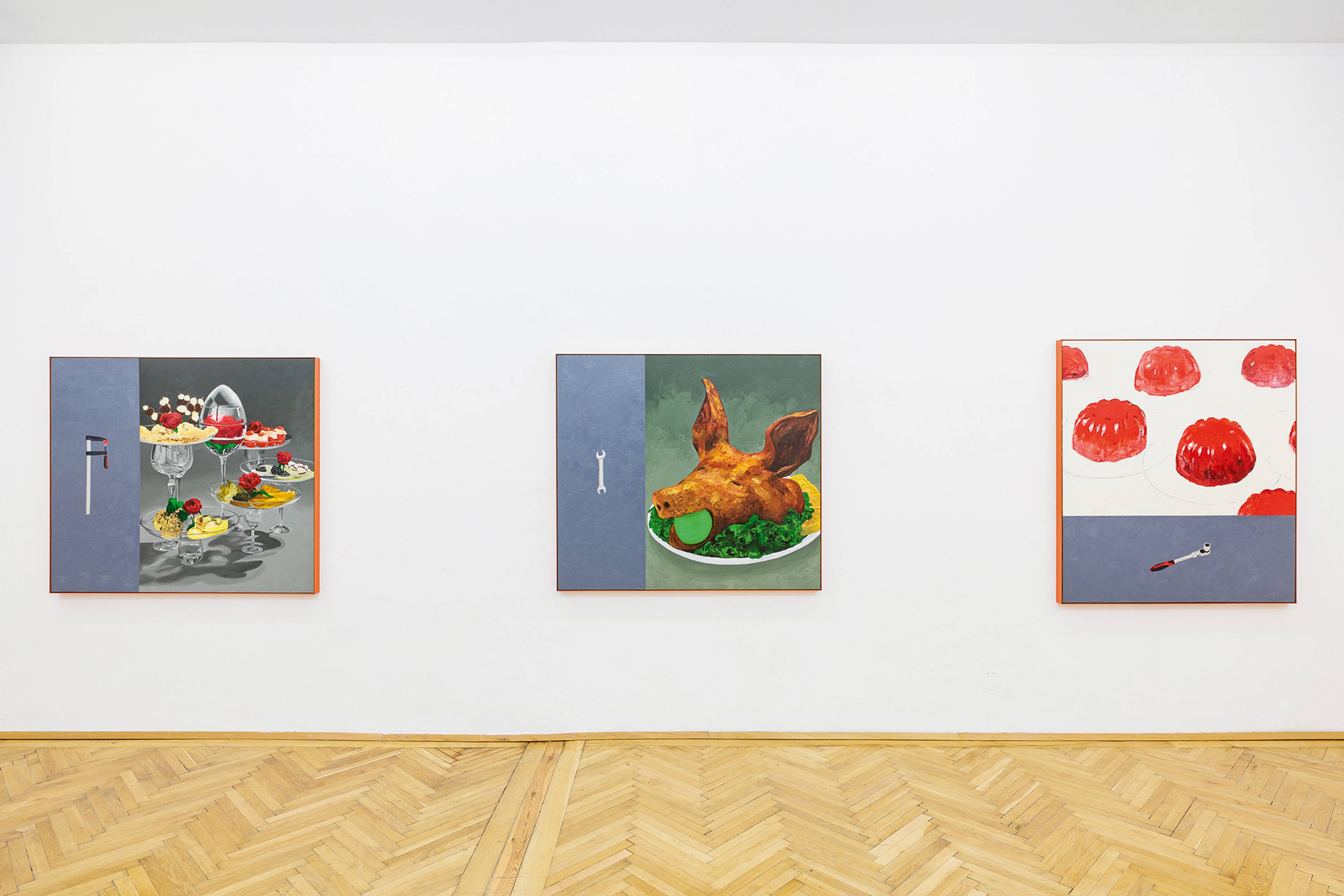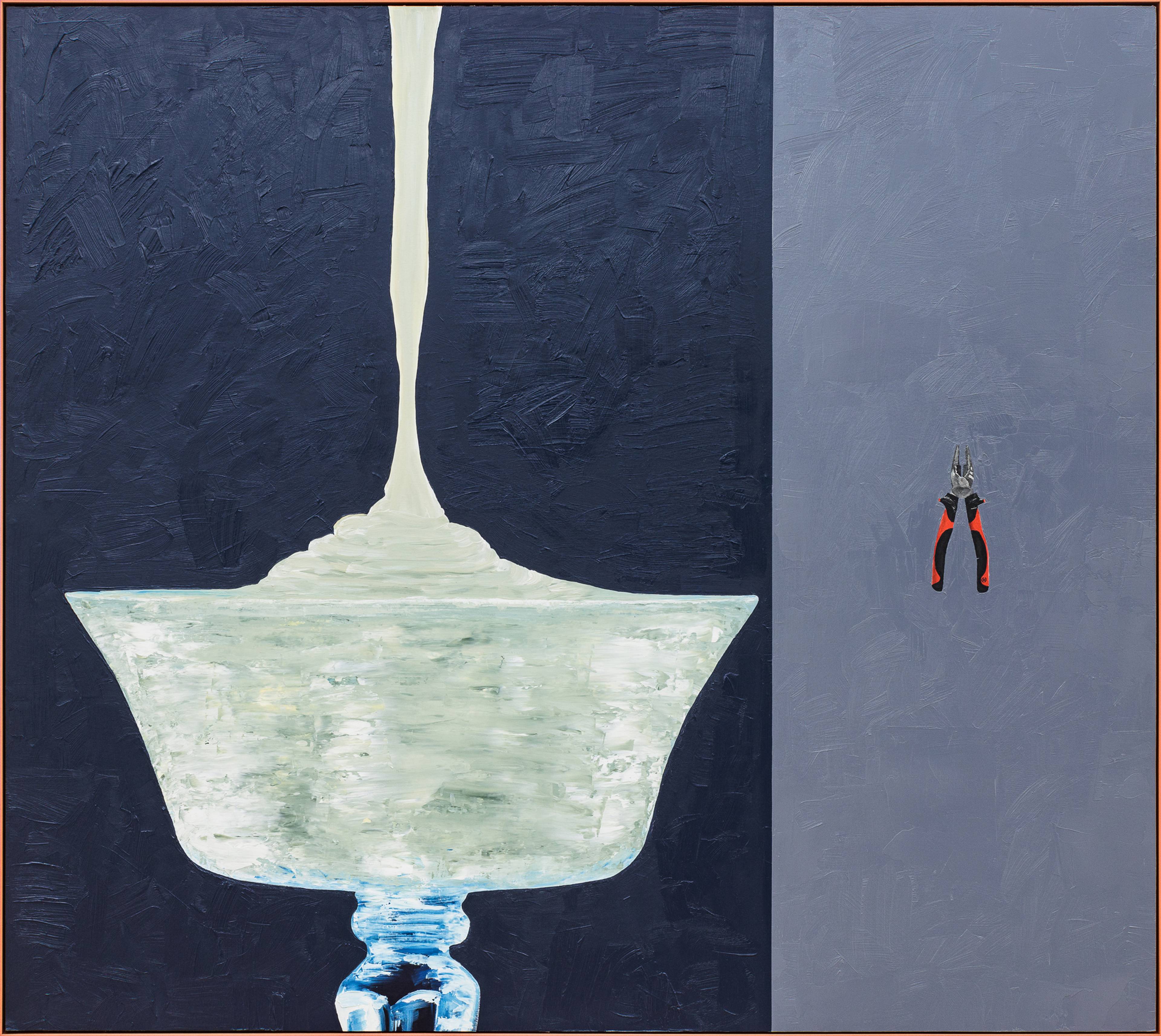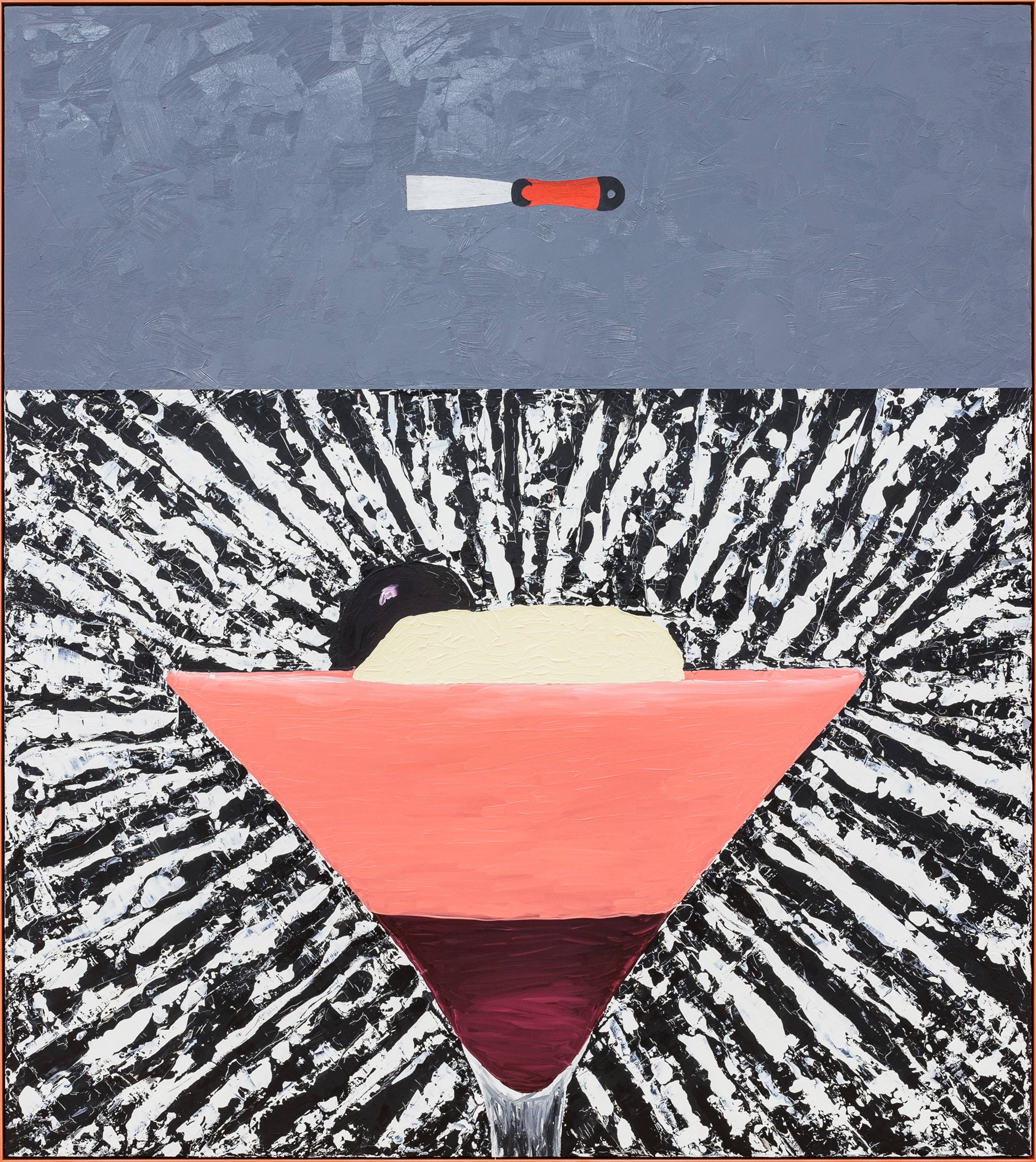“[T]wo tastes, two textures, two elements of different provenance” – this is how Peter Kubelka described the essence of cooking in a previous issue of this magazine. For the Austrian filmmaker, it basically applies to any medium, to language, and even to painting: the coming together and connection of two things – “you bring two thoughts together, or two concepts.”
Milena Büsch’s (*1980) exhibition is about food, but also about contemporary painting, its codes, how we understand them, and the (social) conditions surrounding that understanding, about questions of representation, and, ultimately, about the semiotic; the use and recognition of forms. And, as in Kubelka, it follows a dual structure. Most obviously, all eight paintings are sharply contrasted, their subjects split into two parts: an image from haute or nouvelle cuisine, taken from cookbooks from the 1970s and 80s; and an adjoining, solid-gray area, either horizontal or vertical, centering a common, non-culinary tool. The title painting, Dead Duck (all works 2024), shows a waiter serving an extravagant fowl with raised wings, above a simple level. Other compositions include a putty knife with what looks like a Neapolitan in a martini glass; a clamp with quiche and other snacks in glass-stemmed bowls, decorated with roses; and a ratchet next to bright-red jellied puddings. There’s also a lobster arrangement crowned with roses, paired with a brightly colored mixer (the kind you attach to a drill to mix mortar or paint).
Let’s stick with the formal aspects, where we also see a kind of split. The artist worked with oil on wood-mounted paper, first printing the images – the tools are direct copies from hardware-store signs – then using them as the base for the final painting. She plays with various techniques, adjusting the level of precision, the amount of paint, and its application style, creating works with dramatically varying visual qualities. Noticeable are both a concern with painterly conventions, artistic traditions, and their rules, and their intentional erasure. In some parts, there’s a realistic resemblance, as in the depiction of the tools; elsewhere, the rendering becomes freer, more abstract, rougher, or simply sloppier. Take the apple in the mouth of a pig’s head, ringed with salad and paired with a wrench – a flat, hardly textured, bright green suffices. At other times, the paintings are subject- or genre-compliant, with shiny, thick color and pastosity mimicking the opulent cuisine they depict. There are also signature style references, like the Gerhard Richter-y blur of cream accumulating in a glass bowl next to a pair of tongs, or the cocktail-glass dessert’s crackling background, made to achieve specific painterly surface qualities.
This playful maneuvering between styles or techniques and punkish rule negations allows Büsch’s paintings to step outside pop and appropriation, despite clearly falling within these well-trodden and – somewhat exhausted – fields. It’s hard not to draw associations, for instance, with the eclectic pastiches of David Salle, particularly his “Glass and Mirror Paintings” from the late 1990s, where different image types, abstract compositions, and pictures of drinkware are pieced together in a painterly way. However, Büsch’s images refresh these connections with an artistic (self-)irony that effectively overlays the tired, borrowing logic they’re based on: Is she a dazzling virtuoso or a virtuoso trickster? A cool faker and style mixer – or even a painter at all? Could Milena Büsch herself be the dead duck?
Dead Duck – Zange, 2024, oil on paper on wood, varnish, lacquered metal artist’s frame 116 x 130 x 5 cm
Dead Duck – Spachtel, 2024, oil on paper on wood, varnish, lacquered metal artist’s frame, 130 x 116 x 5 cm
This humorous, circular questioning breaks decisively when we come back to her themes. Things quickly get serious when we pick up on the socio-economic interpretations her paintings lay out, reading the contrasting subjects as emblems or representations of different classes – here the frugal world of workers or artisans, there the extravagant hedonism of the (new rich. This brings to mind Pierre Bourdieu’s theories on social distinction, where class separations are only clarified and deepened through the means of their representation. What matters is not bringing people together, but distinguishing oneself from others: The “choice of fate,” and with it, personal taste, is displayed outwardly and secured, whether from lower or higher levels of the social hierarchy.
But are these really representations of social pressures and oppositions? Maybe the tools are more about a DIY culture linked to a sense of independence (though this too ultimately leads to neoliberal exploitation). We could also return to painting (actually, to Kubelka), which, in the end, is also all about the right proportions, a sophisticated relationship between mastery and exaggeration, between technical sovereignty, skillful craftsmanship, and the deliberate transgression of the discursive status quo, from which something (literally) sensational can emerge. Moreover, if we manage to see the parts of the picture, not separately, but in combination, we might arrive at yet another track: pig’s head with wrench? It’s conceivable that this is exactly what Büsch wants to serve up: things that are difficult to digest, connecting things and meanings that simply cannot be connected. This would take us back to the 1920s and 30s, to the subversive agitprop montages of the Dadaists and Constructivists. In these increasingly authoritarian times, perhaps these would be the right mixes, recipes, menus. Enjoy.
___
“Dead Duck”
FELIX GAUDLITZ, Vienna
8 Feb – 29 Mar 2025
